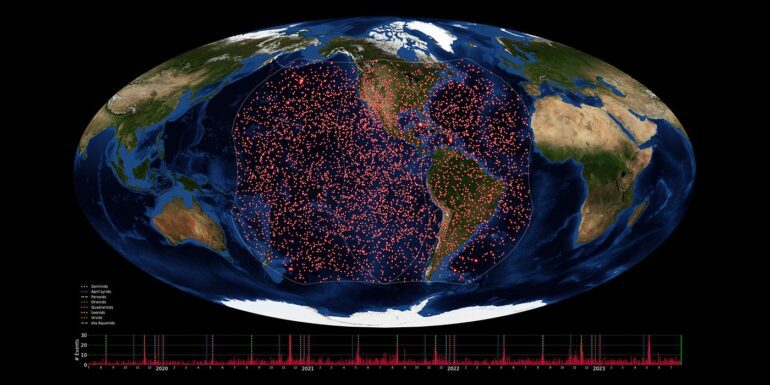TL;DR:
- Collaboration led by Dr. Jeffrey Smith and SETI Institute uses weather satellite data and AI to assess asteroid impact risks.
- Data from NOAA’s GOES Geostationary Lightning Mapper (GLM) instruments were repurposed for analysis.
- GLM detects bolides and large exploding meteors, in addition to lightning strikes.
- The goal is to create a comprehensive dataset of bolide light curves for planetary defense.
- Visualization of bolide activity provides insights into their frequency and potential impact.
Main AI News:
In the quest to comprehend the threats posed by asteroid impacts, scientists have traditionally relied upon a limited arsenal of data sources. These include all-sky video camera systems, sporadic dashcam footage, and anecdotal accounts from eyewitnesses. However, a groundbreaking collaborative effort spearheaded by Dr. Jeffrey Smith, a distinguished data scientist at the renowned SETI Institute, in partnership with esteemed institutions such as NASA, Sandia National Labs, and the University of California, Berkeley, is revolutionizing this approach.
Their innovative strategy involves repurposing data from the constellation of weather satellites meticulously operated by the National Oceanic and Atmospheric Administration (NOAA). In particular, they have turned their attention to the Geostationary Operational Environmental Satellite’s (GOES) Geostationary Lightning Mapper (GLM) instruments. These instruments, primarily designed to detect lightning activity, utilize near-infrared optical sensors to capture momentary fluctuations in light. Yet, within this luminous tapestry of data lies a crucial revelation – some of these luminous events are not mere lightning strikes but rather bolides, massive meteors that detonate upon entry into Earth’s atmosphere.
“Life-threatening asteroids, fortunately, remain exceedingly rare,” explains Dr. Smith. “So, how does one scientifically assess the risks associated with such infrequent occurrences? The answer lies in the study of more common phenomena and extrapolation! The GLM instruments offer us a unique opportunity to identify a diverse spectrum of bright meteors, particularly those within the 0.1 to 3-meter diameter range, which possess the potential to explode upon atmospheric entry – these are the bolides. This wealth of data allows us to fine-tune our entry models, enabling us to evaluate the risk associated with a looming celestial threat and make informed decisions regarding our response. Should we endeavor to alter its trajectory, or is it wiser to allow the harmless object to disintegrate harmlessly within our atmosphere?“
To visualize the activity of fireballs, the research team has ingeniously crafted time-lapse animations derived from four years of bolide data. These mesmerizing animations, showcased at The International Conference for High-Performance Computing, Networking, Storage, and Analysis (SC23), unveil critical insights into the frequency and potential impact of these celestial occurrences. Each explosion depicted represents a bolide, with the intensity of the explosion correlating with its luminosity and, consequently, its potential impact. While many of these bolides likely left minuscule meteorite remnants on Earth’s surface, none of them posed a substantial threat.
Funded by NASA’s Planetary Defense Coordination Office and leveraging NASA’s cutting-edge computing resources, the ultimate objective is to assemble a comprehensive, meticulously calibrated dataset of bolide light curves. This invaluable resource will serve as a beacon, illuminating the planetary defense community on the associated risks tied to meteoroid and substantial asteroid impacts.
Conclusion:
The innovative use of satellite data and AI for asteroid impact risk assessment represents a significant advancement in planetary defense. By leveraging existing resources and repurposing data, this approach enhances our ability to evaluate the potential threats posed by asteroids. This development is poised to drive further research and investment in space-related technologies and infrastructure, creating opportunities for businesses in the space and defense sectors.

